Pep Lijnders Tactics At RB Salzburg
As we will see in this tactical analysis, defensive issues have plagued Red Bull Salzburg during the 2024/25 season.
The problems are possibly due to new coach Pep Lijnders, who came from Liverpool after working with Jürgen Klopp.
Lijnders is a smart coach, but the change in tactics has not been as smooth as Salzburg had hoped, particularly in defence.
Salzburg, known for their attacking style of football, changed their tactics under Lijnders.
His ideas from Klopp’s gegenpressing philosophy were expected to help Salzburg dominate possession and press their opponents.
However, as we will see in this analysis and scout report, this has made the team less stable at the back, especially during transitions.
The numbers show that the team has struggled to balance attack and defence, conceding more goals than in previous seasons.
Red Bull Salzburg Data Analysis
Red Bull Salzburg’s struggles in defence are mainly because of a new playing style introduced by head coach Pep Lijnders, who joined from Liverpool after spending years as Jürgen Klopp’s assistant.
The team has struggled to adapt to Lijnders’ approach, which has led to weaknesses in their play that have affected their performance in both domestic and European matches.
Salzburg have struggled to defend, which has hurt their performance in the Austrian Bundesliga and the UEFA Champions League.
To fix these problems, the team needs to work on its defence.
Pep Lijnders has changed Salzburg’s defensive shape and structure.
Lijnders has made the team more aggressive and focused on possession, similar to what he was used to seeing with Klopp, but it hasn’t been easy.
Salzburg’s defence is no longer as strong as it used to be.
The centre-backs have been struggling to keep up with the pace of the game.
They conceded multiple goals in their Champions League group stage against Sparta Prague due to poor marking and ineffective communication.
Lijnders’ focus on high pressing and attacking play has meant less focus on defence.
Salzburg are pressing more effectively in some areas, but the overall intensity has decreased.
The team is pressing less as a unit, and Salzburg’s pressing is not coordinated, which makes it easy for opponents to exploit gaps in their defence.
Salzburg are now more vulnerable to teams that can bypass their press and attack quickly.
Salzburg’s Passes Per Defensive Action (PPDA) has risen from 7.24 to 7.73 — this shows they are somewhat less able to stop the opposition and get the ball back.
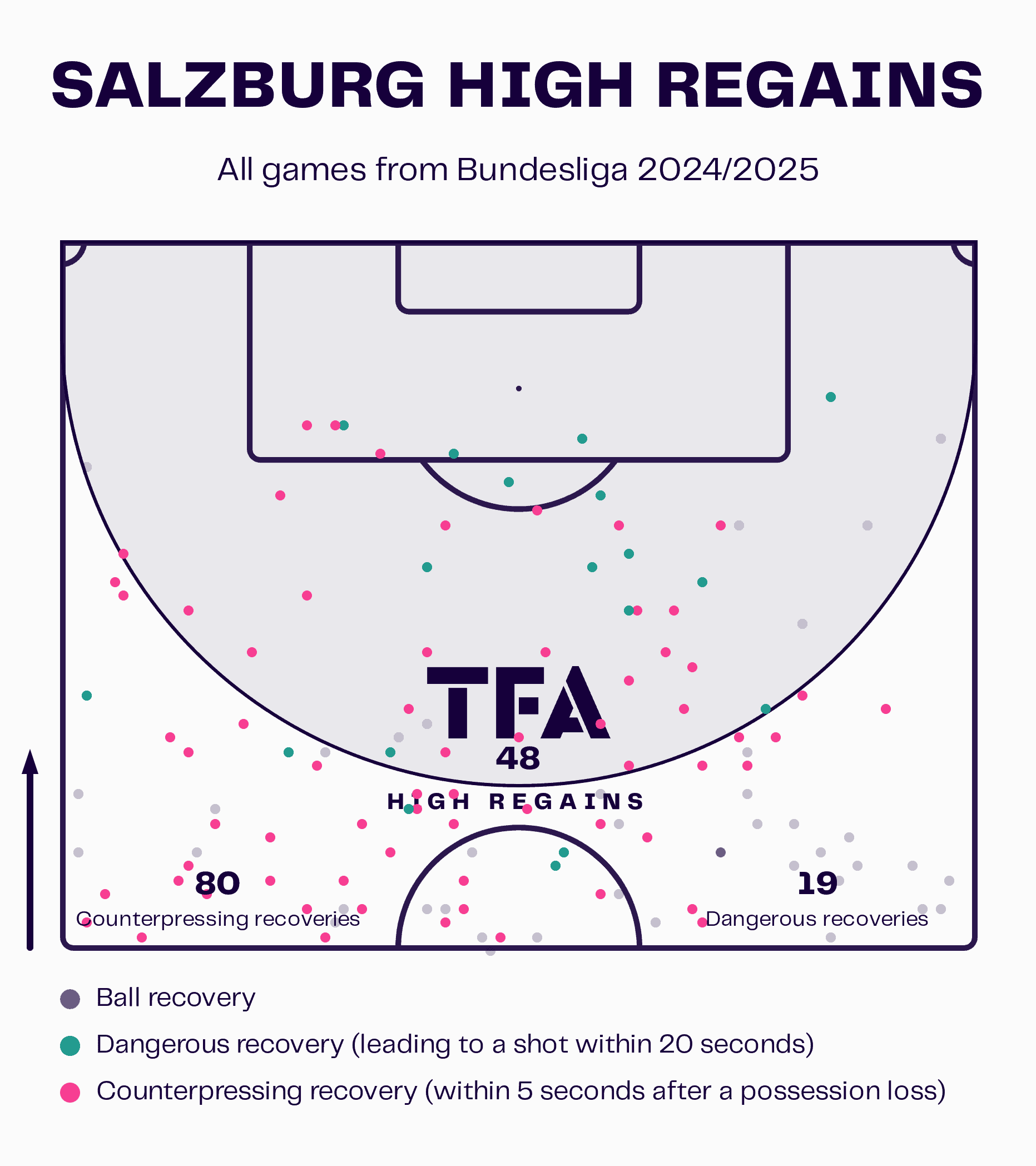
Salzburg are prone to high pressing.
The defenders have struggled this season, unlike last season when they played out from the back with more control.
Other teams are marking Salzburg aggressively and pressing them high, which disrupts their play.
The centre-backs have struggled, with few passing options in midfield.
This has led to many turnovers in dangerous areas, resulting in goals for the opposition.
Salzburg’s defence is weak against long balls.
Opposing teams have passed directly to players in the space between the centre-backs.
These long balls, played centrally, have caught Salzburg’s defenders off-guard.
The centre-backs have struggled to deal with these passes, which have led to a number of clear chances for the opposition.
More goals are being scored against Salzburg this season.
Last season, they conceded 0.82 goals per 90 minutes; this season, it’s 1.39.
The team has been losing more and more in high-stakes matches because their defence is not strong enough to deal with long, direct passes from the opposition.
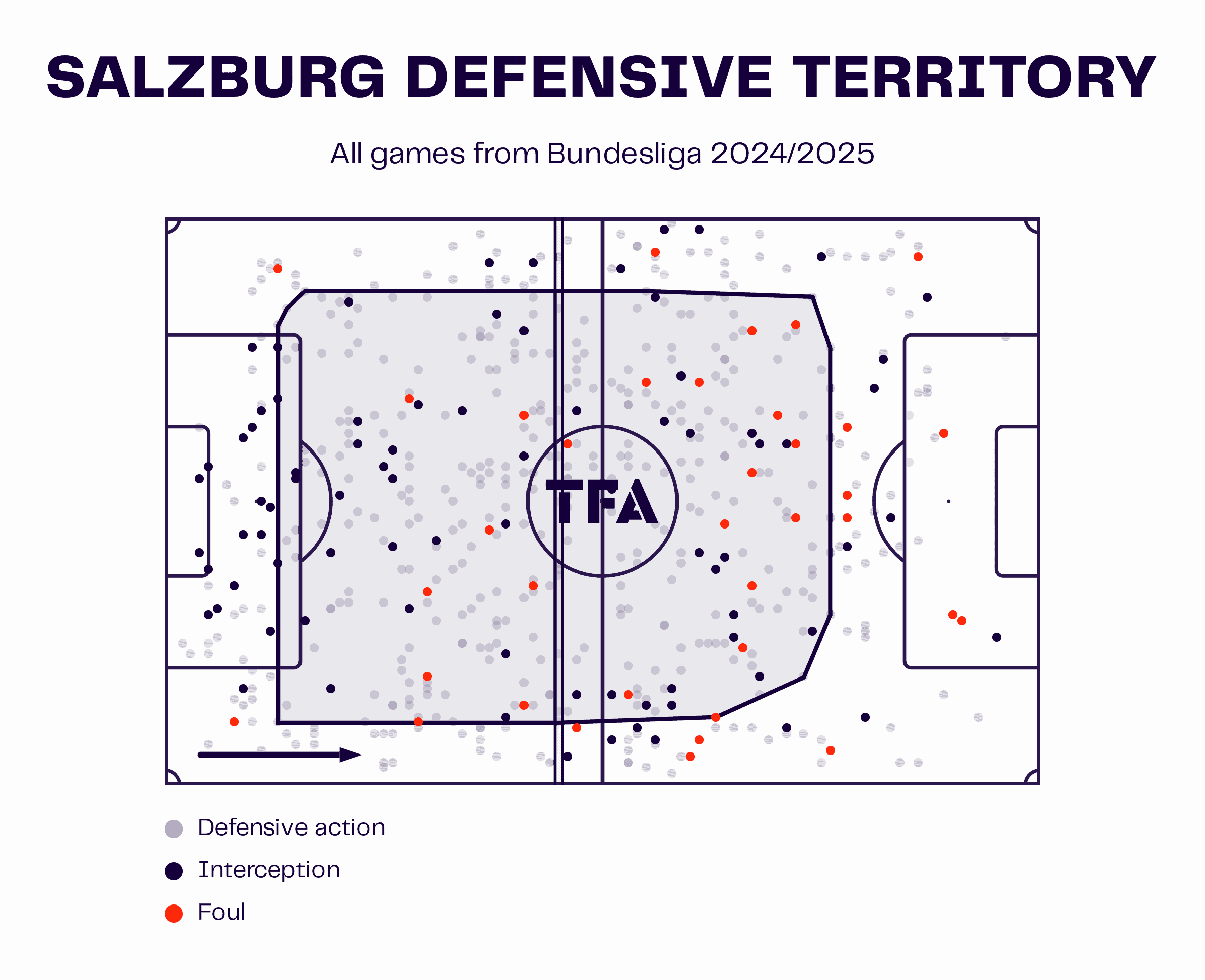
Salzburg have also struggled to defend crosses and set pieces.
Salzburg’s defenders often fail to mark their opponents effectively despite having the advantage in their own box.
Opposing teams have had too much space in Salzburg’s penalty area, scoring from headers and second balls.
This is worrying because the team was solid in these situations last season.
Defenders have been distracted during key moments, allowing opponents to score.
Salzburg are vulnerable even when they have the numerical advantage because there is no clear marking and poor communication in their defensive unit.
Salzburg are also losing their aerial dominance.
Last season, the team averaged 37.62 aerial duels per 90 minutes; this season, it is 25.91.
Salzburg are struggling to defend crosses and battles in the air.
This means opponents can take advantage of Salzburg’s poor ball clearance, creating more chances and goals.
Under Lijnders, the team now has more possession (65.7% this season compared to 58.5% last season), but this has not made them better at defending.
Salzburg are more exposed defensively because it commits more players forward and leaves fewer defenders to cover during transitions.
When Salzburg lose the ball, the defenders are often slow to get back and let in counterattacks.
The rise in expected goals conceded per 90 minutes shows that the team is more vulnerable at the back.
Salzburg’s build-up play relies on defenders and midfielders to maintain possession and progress the ball.
There have been more passes per 90 minutes this season than last, showing a shift towards a more patient, ball-dominant approach.
However, Salzburg’s defenders are now facing more pressure from opponents as they try to build from the back.
The team struggles against high-pressing opponents.
They find it hard to pass when they are under pressure, which has led to mistakes that have let the opposition score.
Salzburg’s attack is still strong.
The team is taking more shots (16.43 this season vs 13.15 last season) and scoring more (2.33 expected goals per 90 minutes).
However, this attacking skill has not made up for the defensive problems, costing them points in the Austrian Bundesliga and the Champions League.
Playing Out From The Back
Salzburg’s defence struggles to play out from the back under pressure.
Lijnders’ system has shown that the defenders and midfielders need to work better together when opponents press high.
Salzburg’s central defenders often have few passing options, making them prone to turnovers.
To fix this, we need to do several things.
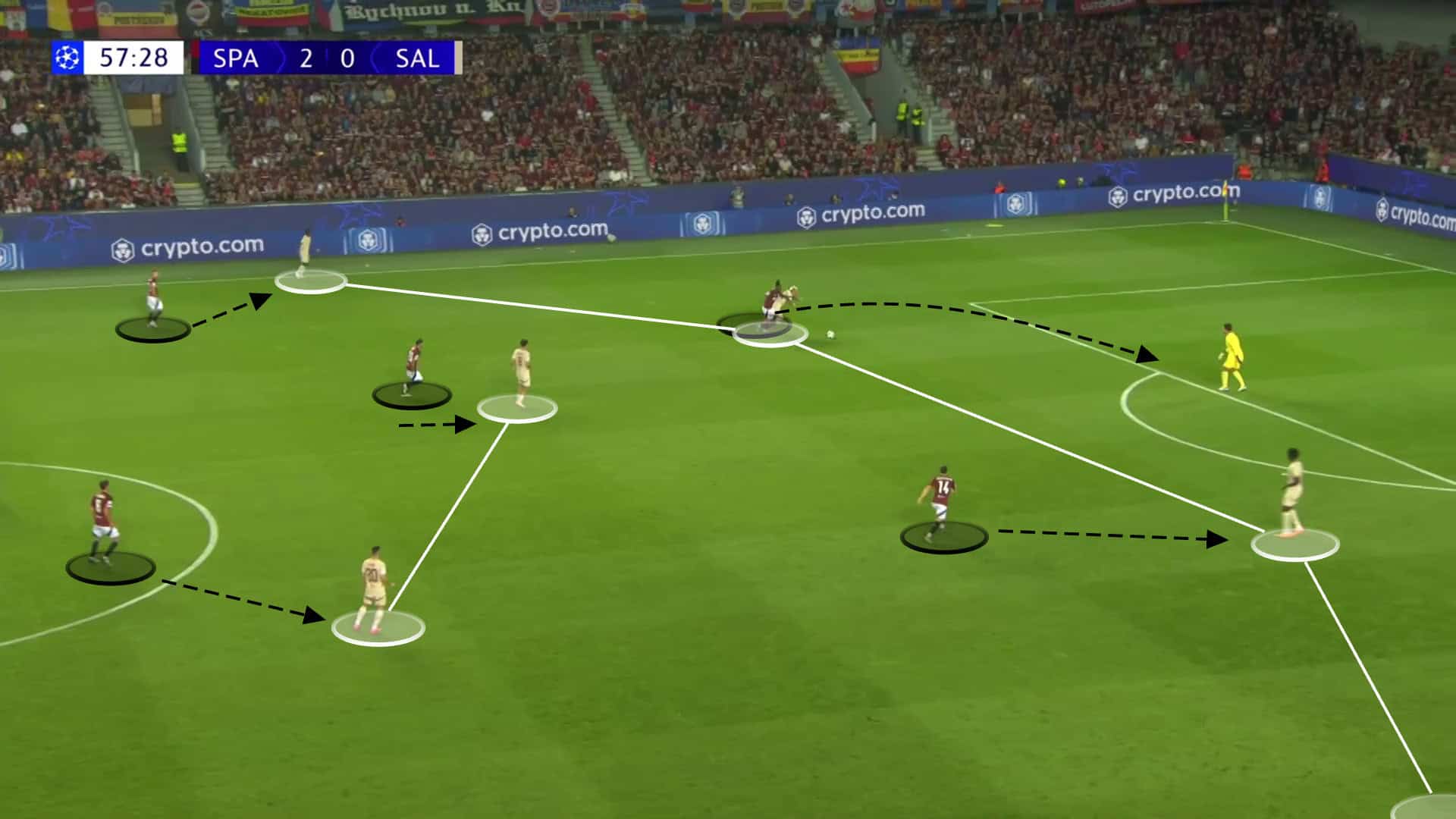
The midfielders need to support the central defenders more, especially against teams that press hard.
Salzburg’s midfielders are too high during build-up play, leaving defenders without outlets.
The solution is for the midfielders to drop deeper when the team is building from the back.
This could create a “double pivot” in front of the backline, giving the defenders more passing options and more players in their own half.
Salzburg can get past the press more easily, and the centre-backs will be less pressured.
Salzburg’s full-backs should help the team move the ball up the pitch.
Staying wider and higher up the pitch lets full-backs stretch the opposition’s press and create passing lanes for central defenders.
However, they should move at the right time to stop opponents from getting through.
If full-backs push forward while one stays back, it would help the team defend better.
Defenders must be calmer when facing a high press.
Salzburg’s defenders often panic under pressure and make bad passes.
They need to make better decisions when they have the ball, stay calm under pressure, and make quicker decisions, all of which can be improved by focused training.
Vulnerability To Long Balls
Another critical defensive issue for Salzburg has been their susceptibility to long balls over the top.
Opposing teams have frequently exploited the space behind Salzburg’s backline by playing direct passes between the central defenders.
This tactic has been effective because Salzburg’s defence has struggled to maintain positional discipline and lacks the pace or awareness to react to these direct threats.
To address this, Salzburg need to implement both tactical and positional adjustments.
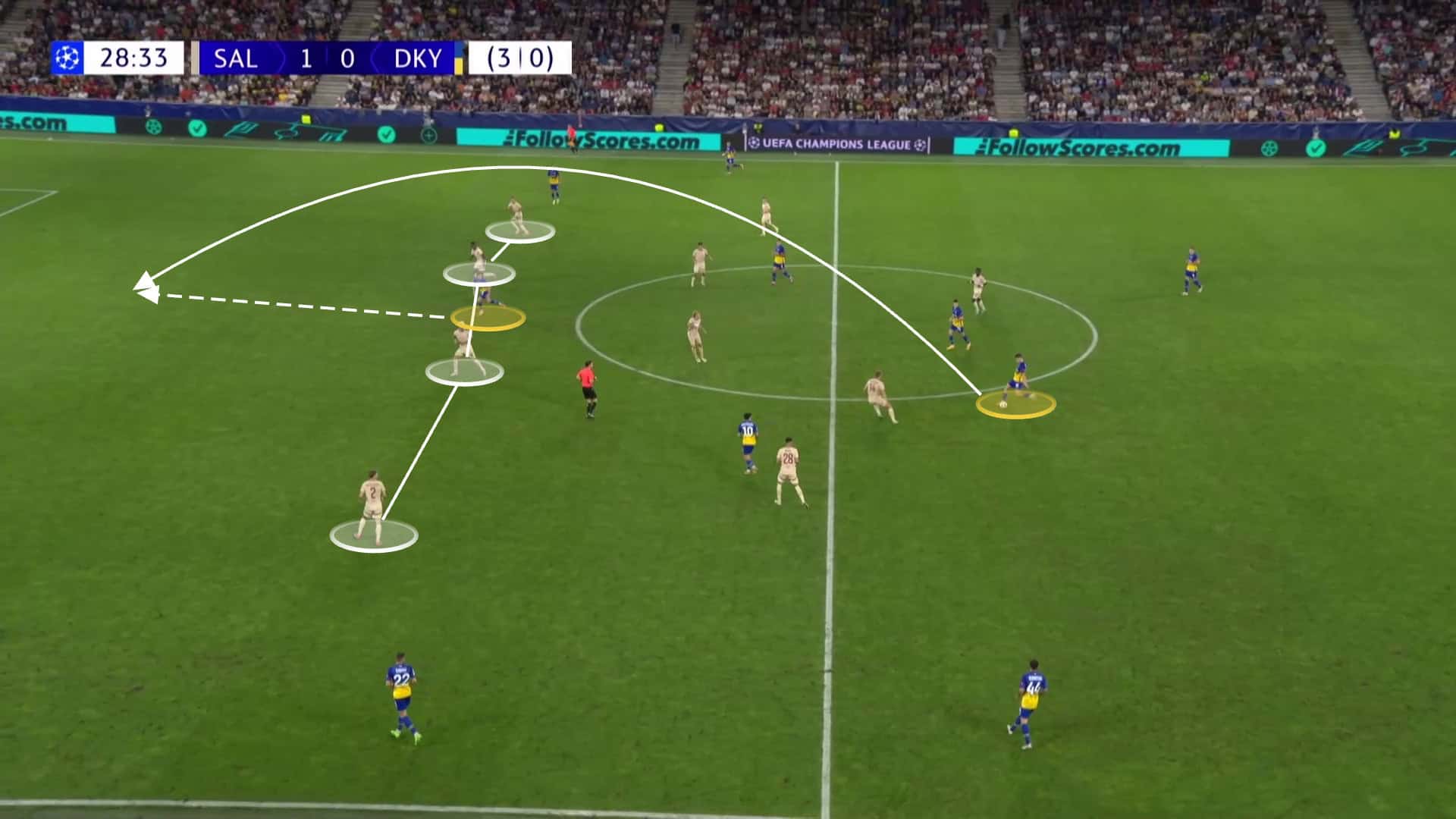
The central defenders must improve their positional awareness, particularly in situations where long balls are likely to be played.
One of the issues Salzburg faces is that their centre-backs are often caught out of position, allowing opposing forwards to make runs into the space behind them.
Salzburg’s defensive line must be more disciplined in maintaining shape to mitigate this.
This could be achieved by positioning the centre-backs slightly deeper in certain phases of play, especially when facing teams that rely heavily on direct, long passes.
By adopting a more cautious and conservative defensive line in these situations, Salzburg’s defenders will have more time to react to long balls and prevent opposing attackers from breaking through.
This approach would help reduce the number of one-on-one situations that the defenders face where they are currently being overrun or outpaced by faster forwards.
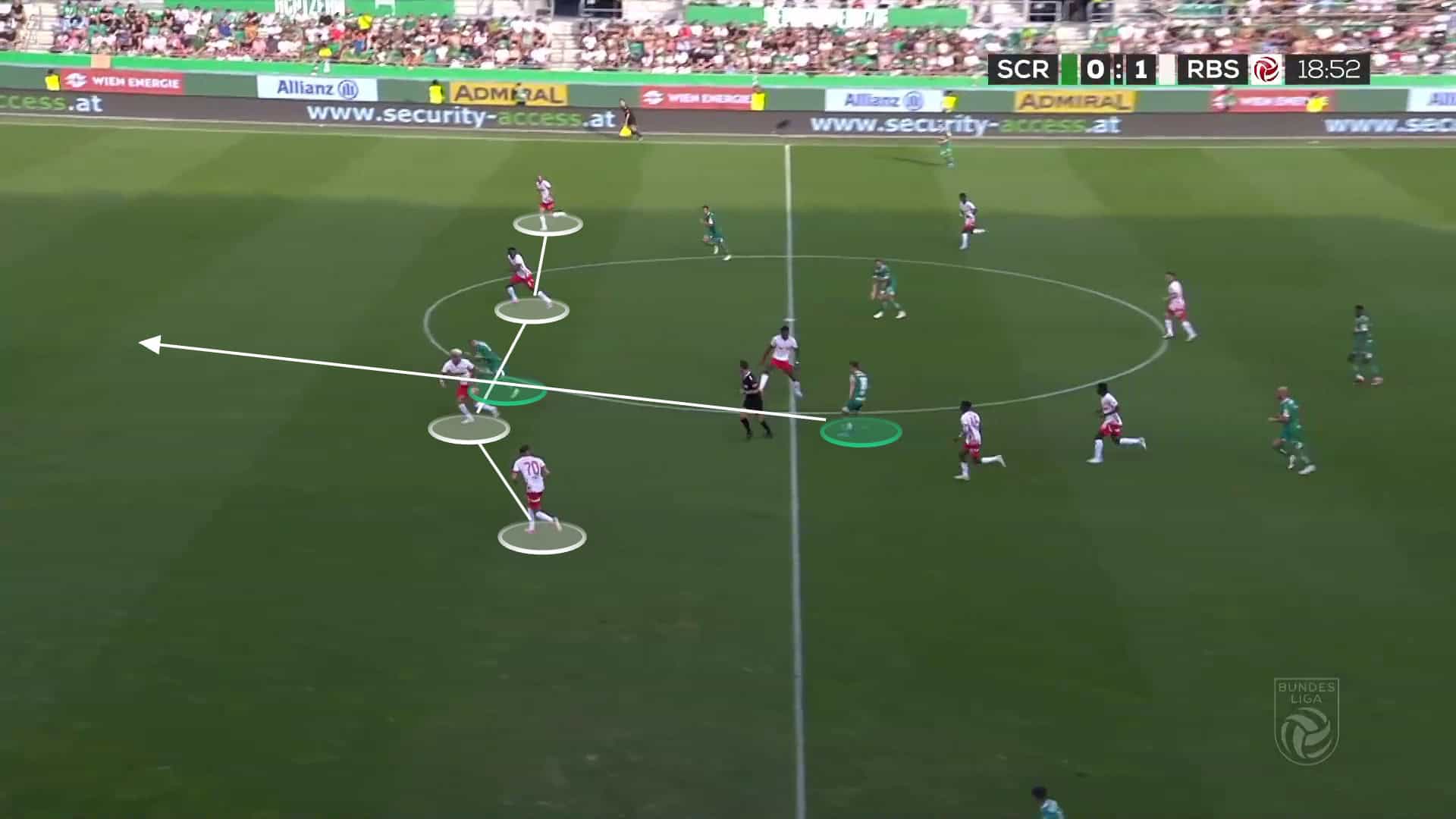
Salzburg’s goalkeeper can also play a crucial role in mitigating the team’s vulnerability to long balls.
Employing a sweeper-keeper—someone who can aggressively come off their line to intercept long balls played over the top—would help neutralise direct threats.
While the goalkeeper must be cautious not to leave the goal unguarded, a well-timed intervention can stop dangerous long balls from becoming clear-cut scoring opportunities.
However, this strategy depends on both the timing and judgment of the goalkeeper, as well as clear communication with the backline to avoid mix-ups.
In addition to improving their own positioning, Salzburg’s centre-backs must work in closer coordination with the full-backs.
Full-backs often push high up the pitch in Lijnders’ system, leaving the central defenders exposed.
If the full-backs are caught too far forward during a defensive transition, the centre-backs are left to defend large spaces on their own, making them vulnerable to long passes.
One solution is for the centre-backs and full-backs to communicate more effectively, ensuring that at least one full-back stays back when the other pushes forward.
This rotational system would provide better coverage and reduce the chances of being caught out by long balls.
Defending Set Pieces and Crosses
Salzburg’s vulnerability in set-piece situations has become a recurring theme this season, with opponents often capitalizing on poor marking and disorganization in the box.
Despite frequently having a numerical advantage in defensive set-piece situations, Salzburg’s defenders have been unable to track runners or contest aerial duels effectively.
To fix these issues, Salzburg must improve both their marking assignments and their aerial dominance.
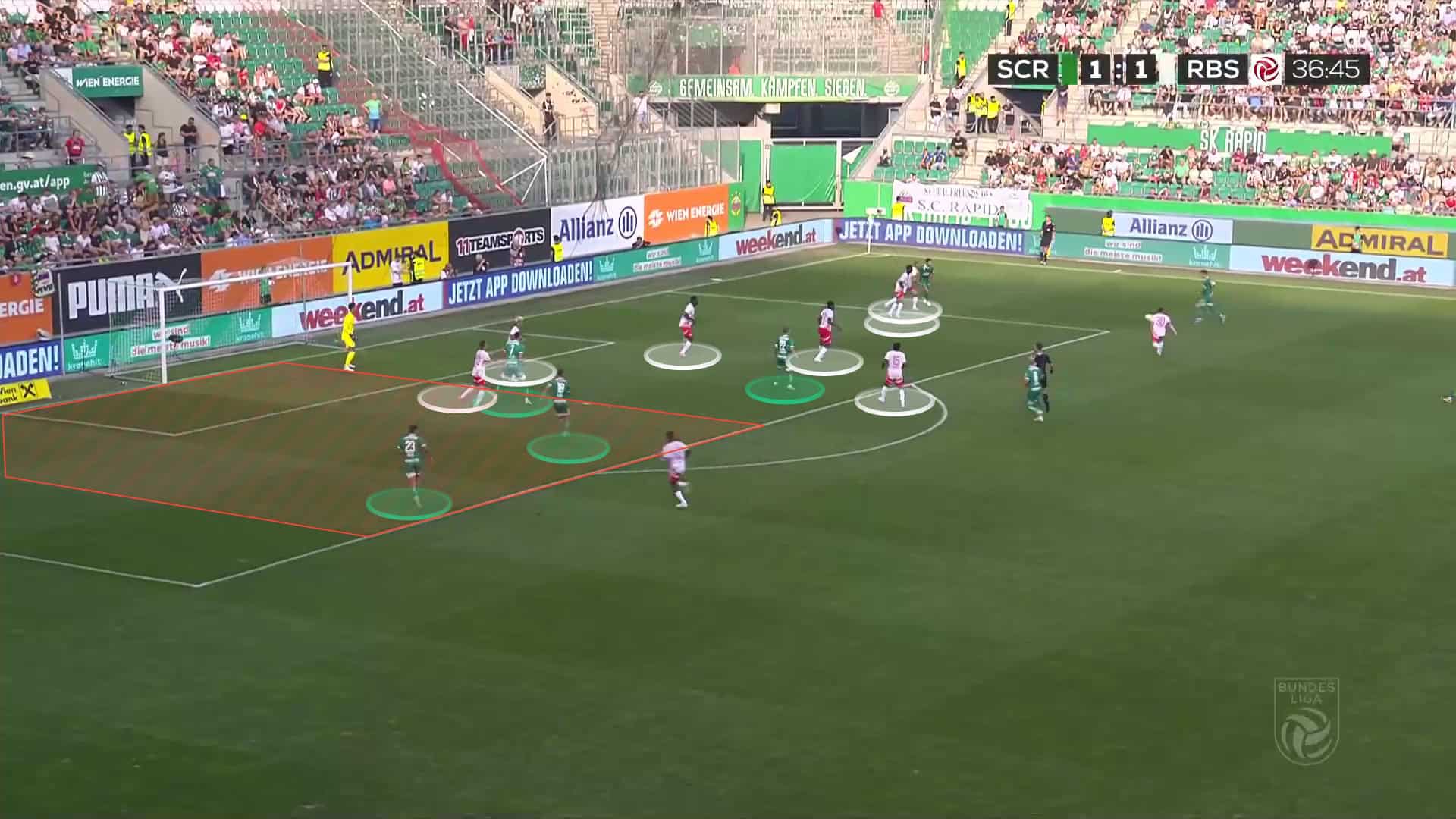
One potential solution to Salzburg’s marking issues is to shift away from pure man-marking in set-piece situations and adopt either a zonal marking system or a hybrid system that combines zonal and man-marking principles.
A zonal system assigns each defender a specific area of the penalty box to cover rather than a specific opponent to mark.
This approach ensures that no area is left unguarded, making it harder for opposing players to find space in the box.
A hybrid system would blend zonal marking with man-marking, allowing defenders to closely mark key opposing players while also ensuring that crucial areas of the penalty box are adequately covered.
Another key component to improving Salzburg’s defending on set pieces is their ability to win aerial duels.
This season, Salzburg has seen a marked decline in their success rate in aerial challenges, with their average number of aerial duels per 90 minutes dropping from 37.62 last season to 25.91 this season.
To address this, Salzburg’s defenders need to focus on improving their timing and positioning when contesting aerial balls.
This involves not only individual strength and jumping ability but also a better understanding of when and where to challenge for the ball.
One way to improve aerial dominance is through targeted training that focuses on aerial duels, particularly in crowded areas like the penalty box.
Defenders must work on their ability to outjump and outmuscle their opponents, ensuring that they are first to the ball in set-piece situations.
Conclusion
Red Bull Salzburg’s defensive struggles this season can be attributed to a combination of tactical changes, individual errors, and a lack of cohesion at the back.
While Pep Lijnders’ new playing style has brought about some positive developments, particularly in terms of attacking play and possession, it has also exposed significant defensive vulnerabilities.
To be successful again, Salzburg must improve their ability to play out from the back under pressure, address their susceptibility to long balls, tighten up their marking on set pieces, and find a better balance between attack and defence.
If these issues are not addressed, Salzburg risks falling short of their usual high standards in both domestic and European competition.

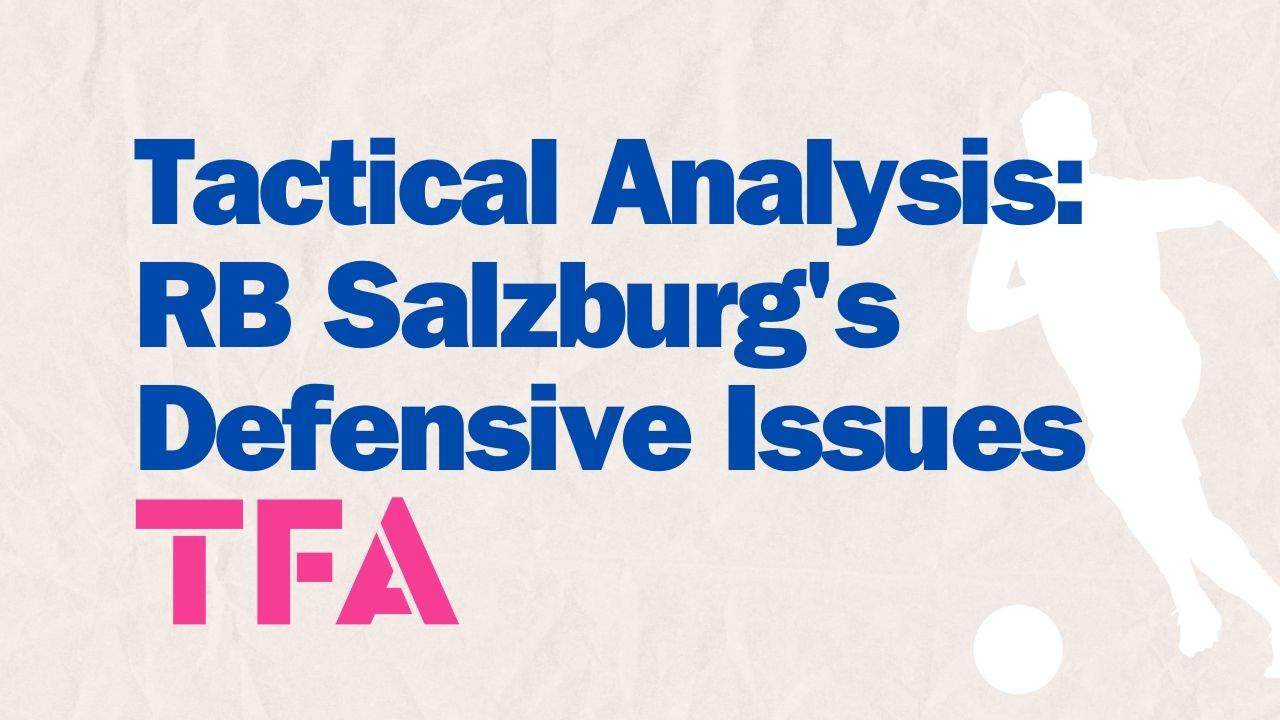



Comments